Seed Halopriming: A Promising Strategy to Induce Salt Tolerance in Indonesian Pigmented Rice
Abstract
1. Introduction
2. Results
2.1. Effects of Seed Halopriming on Germination
2.2. Plant Growth and Relative Water Content (RWC)
2.3. Total ROS Contents and Membrane Stability Index
2.4. Photosynthetic Pigment Contents
2.5. Proline Contents
2.6. Stress-Induced Gene Expression
2.6.1. Expression of Proline Biosynthesis Genes
2.6.2. Expression of Antioxidant Genes
2.6.3. Expression of TF-Related Genes
3. Discussion
4. Materials and Methods
4.1. Seed Halopriming
4.2. Seed Germination
4.3. Salt-Stress Treatment and Phenotypic Assessment
4.4. Quantification of Chlorophyll and Carotenoid Contents
4.5. Analysis of Total ROS Contents
4.6. Analysis of Membrane Stability Index
4.7. Quantification of Proline Content
4.8. Total RNA Isolation and RT-qPCR for Gene Expression Analysis
4.9. Statistical Analysis
Author Contributions
Funding
Data Availability Statement
Acknowledgments
Conflicts of Interest
References
- Chen, T.; Shabala, S.; Niu, Y.; Chen, Z.H.; Shabala, L.; Meinke, H.; Venkataraman, G.; Pareek, A.; Xu, J.; Zhou, M. Molecular mechanisms of salinity tolerance in rice. Crop J. 2021, 9, 506–520. [Google Scholar] [CrossRef]
- Yawadio, R.; Tanimori, S.; Morita, N. Identification of phenolic compounds isolated from pigmented rices and their aldose reductase inhibitory activities. Food Chem. 2007, 101, 1616–1625. [Google Scholar] [CrossRef]
- Nam, S.H.; Choi, S.P.; Kang, M.Y.; Koh, H.J.; Kozukue, N.; Friedman, M. Antioxidative activities of bran extracts from twenty one pigmented rice cultivars. Food Chem. 2006, 94, 613–620. [Google Scholar] [CrossRef]
- Hyun, J.W.; Chung, H.S. Cyanidin and Malvidin from Oryza sativa cv. Heugjinjubyeo Mediate Cytotoxicity against Human Monocytic Leukemia Cells by Arrest of G 2/M Phase and Induction of Apoptosis. J. Agric. Food Chem. 2004, 52, 2213–2217. [Google Scholar] [CrossRef]
- Tsuda, T.; Horio, F.; Uchida, K.; Aoki, H.; Osawa, T. Dietary cyanidin 3-O-β-D-glucoside-rich purple corn color prevents obesity and ameliorates hyperglycemia in mice. J. Nutr. 2003, 133, 2125–2130. [Google Scholar] [CrossRef]
- Pratiwi, R.; Purwestri, Y.A. Black rice as a functional food in Indonesia. Funct. Foods Health Dis. 2017, 7, 182–194. [Google Scholar] [CrossRef]
- Dwiatmini, K.; Afza, H. Anthocyanin Content Characterization on Pigmented Local Rice as Genetic Resources of Functional Food. Bul. Plasma Nutfah 2018, 24, 125. [Google Scholar] [CrossRef]
- Munns, R.; Tester, M. Mechanisms of Salinity Tolerance. Annu. Rev. Plant Biol. 2008, 59, 651–681. [Google Scholar] [CrossRef]
- Huang, L.; Zhang, F.; Zhang, F.; Wang, W.; Zhou, Y.; Fu, B.; Li, Z. Comparative transcriptome sequencing of tolerant rice introgression line and its parents in response to drought stress. BMC Genom. 2014, 15, 1–16. [Google Scholar] [CrossRef]
- Asch, F.; Dingkuhn, M.; Dorffling, K. Salinity increases CO2 assimilation but reduces growth in field-grown, irrigated rice. Plant Soil 2000, 218, 1–10. [Google Scholar] [CrossRef]
- Silva-Ortega, C.O.; Ochoa-Alfaro, A.E.; Reyes-Agüero, J.A.; Aguado-Santacruz, G.A.; Jiménez-Bremont, J.F. Salt stress increases the expression of p5cs gene and induces proline accumulation in cactus pear. Plant Physiol. Biochem. 2008, 46, 82–92. [Google Scholar] [CrossRef]
- Munns, R.; Gilliham, M. Tansley insight Salinity tolerance of crops—what is the cost? New Phytol. 2015, 208, 668–673. [Google Scholar] [CrossRef]
- Khong, G.N.; Richaud, F.; Coudert, Y.; Pati, P.K.; Santi, C.; Périn, C.; Breitler, J.C.; Meynard, D.; Vinh, D.N.; Guiderdoni, E.; et al. Modulating rice stress tolerance by transcription factors. Biotechnol. Genet. Eng. Rev. 2008, 25, 381–404. [Google Scholar] [CrossRef]
- Menezes-Benavente, L.; Teixeira, F.K.; Kamei, C.L.A.; Margis-Pinheiro, M. Salt stress induces altered expression of genes encoding antioxidant enzymes in seedlings of a Brazilian indica rice (Oryza sativa L.). Plant Sci. 2004, 166, 323–331. [Google Scholar] [CrossRef]
- Gupta, S.; Dong, Y.; Dijkwel, P.P.; Mueller-Roeber, B.; Gechev, T.S. Genome-wide analysis of ROS antioxidant genes in resurrection species suggest an involvement of distinct ROS detoxification systems during desiccation. Int. J. Mol. Sci. 2019, 20, 3101. [Google Scholar] [CrossRef]
- Nounjan, N.; Nghia, P.T.; Theerakulpisut, P. Exogenous proline and trehalose promote recovery of rice seedlings from salt-stress and differentially modulate antioxidant enzymes and expression of related genes. J. Plant Physiol. 2012, 169, 596–604. [Google Scholar] [CrossRef]
- Refli; Purwestri, Y. A. The response of antioxidant genes in rice (Oryza sativa L.) seedling Cv. Cempo Ireng under drought and salinity stresses. AIP Conf. Proc. 2016, 1744, 020047. [Google Scholar] [CrossRef]
- Marthandan, V.; Geetha, R.; Kumutha, K.; Renganathan, V.G.; Karthikeyan, A.; Ramalingam, J. Seed priming: A feasible strategy to enhance drought tolerance in crop plants. Int. J. Mol. Sci. 2020, 21, 8258. [Google Scholar] [CrossRef]
- Biswas, S.; Biswas, A.K.; De, B. Influence of sodium chloride on growth and metabolic reprogramming in nonprimed and haloprimed seedlings of blackgram (Vigna mungo L.). Protoplasma 2020, 257, 1559–1583. [Google Scholar] [CrossRef]
- Benitez, L.C.; Vighi, I.L.; Auler, P.A.; do Amaral, M.N.; Moraes, G.P.; dos Santos Rodrigues, G.; da Maia, L.C.; de Magalhães Júnior, A.M.; Braga, E.J.B. Correlation of proline content and gene expression involved in the metabolism of this amino acid under abiotic stress. Acta Physiol. Plant. 2016, 38, 267. [Google Scholar] [CrossRef]
- Butt, H.I.; Yang, Z.; Gong, Q.; Chen, E.; Wang, X.; Zhao, G.; Ge, X.; Zhang, X.; Li, F. GaMYB85, an R2R3 MYB gene, in transgenic Arabidopsis plays an important role in drought tolerance. BMC Plant Biol. 2017, 17, 1–17. [Google Scholar] [CrossRef]
- Rahaie, M.; Xue, G.P.; Naghavi, M.R.; Alizadeh, H.; Schenk, P.M. A MYB gene from wheat (Triticum aestivum L.) is up-regulated during salt and drought stresses and differentially regulated between salt-tolerant and sensitive genotypes. Plant Cell Rep. 2010, 29, 835–844. [Google Scholar] [CrossRef]
- Buti, M.; Baldoni, E.; Formentin, E.; Milc, J. A Meta-Analysis of Comparative Transcriptomic Data Reveals a Set of Key Genes Involved in the Tolerance to Abiotic Stresses in Rice. Int. J. Mol. Sci. 2019, 20, 5662. [Google Scholar] [CrossRef]
- Mansuri, R.M.; Shobbar, Z.; Jelodar, N.B.; Ghaffari, M. Salt tolerance involved candidate genes in rice: An integrative meta-analysis approach. BMC Plant Biol. 2020, 20, 1–14. [Google Scholar] [CrossRef]
- Pillai, S.E.; Kumar, C.; Patel, H.K.; Sonti, R. V Overexpression of a cell wall damage induced transcription factor, OsWRKY42, leads to enhanced callose deposition and tolerance to salt stress but does not enhance tolerance to bacterial infection. BMC Plant Biol. 2018, 18, 1–15. [Google Scholar] [CrossRef]
- Shankar, R.; Bhattacharjee, A.; Jain, M. Transcriptome analysis in different rice cultivars provides novel insights into desiccation and salinity stress responses. Sci. Rep. 2016, 6, 1–15. [Google Scholar] [CrossRef]
- Zhu, N.; Cheng, S.; Liu, X.; Du, H.; Dai, M.; Zhou, D.X.; Yang, W.; Zhao, Y. The R2R3-type MYB gene OsMYB91 has a function in coordinating plant growth and salt stress tolerance in rice. Plant Sci. 2015, 236, 146–156. [Google Scholar] [CrossRef]
- Razzaque, S.; Elias, S.M.; Haque, T.; Biswas, S.; Jewel, G.M.N.A.; Rahman, S.; Weng, X.; Ismail, A.M.; Walia, H.; Juenger, T.E.; et al. Gene Expression analysis associated with salt stress in a reciprocally crossed rice population. Sci. Rep. 2019, 9, 1–17. [Google Scholar] [CrossRef]
- Gong, P.; Luo, Y.; Huang, F.; Chen, Y.; Zhao, C.; Wu, X.; Li, K.; Yang, X. Disruption of a Upf1-like helicase-encoding gene OsPLS2 triggers light-dependent premature leaf senescence in rice. Plant Mol. Biol. 2019, 100, 133–149. [Google Scholar] [CrossRef]
- Li, J.; Besseau, S.; Petri, T. Defense-related transcription factors WRKY70 and WRKY54 modulate osmotic stress tolerance by regulating stomatal aperture in Arabidopsis. New Phytol. 2013, 200, 457–472. [Google Scholar] [CrossRef]
- Flowers, T.J. Improving crop salt tolerance. J. Exp. Bot. 2004, 55, 307–319. [Google Scholar] [CrossRef]
- Savvides, A.; Ali, S.; Tester, M.; Fotopoulos, V. Chemical Priming of Plants Against Multiple Abiotic Stresses: Mission Possible? Trends Plant Sci. 2016, 21, 329–340. [Google Scholar] [CrossRef]
- Vaktabhai, C.K.; Kumar, S. Seedling invigouration by halo priming in tomato against salt stress. J. Pharmacogn. Phytochem. 2017, 6, 716–722. [Google Scholar]
- Cheng, J.; Wang, L.; Zeng, P.; He, Y.; Zhou, R.; Zhang, H.; Wang, Z. Identification of genes involved in rice seed priming in the early imbibition stage. Plant Biol. 2016, 19, 61–69. [Google Scholar] [CrossRef]
- Paul, S.; Roychoudhury, A. Effect of seed priming with spermine/spermidine on transcriptional regulation of stress-responsive genes in salt-stressed seedlings of an aromatic rice cultivar. Plant Gene 2017, 11, 133–142. [Google Scholar] [CrossRef]
- Afzal, I.; Butt, A.; Rehman, H.U.; Basra, S.M.A.; Afzal, A. Alleviation of salt stress in fine aromatic rice by seed priming. Aust. J. Crop Sci. 2012, 6, 1401–1407. [Google Scholar]
- Iqbal, M.; Ashraf, M. Seed preconditioning modulates growth, ionic relations, and photosynthetic capacity in adult plants of hexaploid wheat under salt stress. J. Plant Nutr. 2007, 30, 381–396. [Google Scholar] [CrossRef]
- Chen, X.; Zhang, R.; Li, B.; Cui, T.; Liu, C.; Liu, C.; Chen, B.; Zhou, Y. Alleviation of Oxidative Damage Induced by CaCl2 Priming Is Related to Osmotic and Ion Stress Reduction Rather Than Enhanced Antioxidant Capacity During Germination Under Salt Stress in Sorghum. Front. Plant Sci. 2022, 13, 1–13. [Google Scholar] [CrossRef]
- Hidayah, A.; Nisak, R.R.; Susanto, F.A.; Nuringtyas, T.R.; Yamaguchi, N.; Purwestri, Y.A. Seed Halopriming Improves Salinity Tolerance of Some Rice Cultivars During Seedling Stage. Bot. Stud. 2022, 63, 1–12. [Google Scholar] [CrossRef]
- Gour, T.; Sharma, A.; Lal, R.; Heikrujam, M.; Gupta, A.; Agarwal, L.K.; Chetri, S.P.K.; Kumar, R.; Sharma, K. Amelioration of the physio-biochemical responses to salinity stress and computing the primary germination index components in cauliflower on seed priming. Heliyon 2023, 9, e14403. [Google Scholar] [CrossRef]
- Ghanbari, F.; Bag-Nazari, M.; Azizi, A. Exogenous application of selenium and nano-selenium alleviates salt stress and improves secondary metabolites in lemon verbena under salinity stress. Sci. Rep. 2023, 13, 5352. [Google Scholar] [CrossRef]
- Khalequzzaman; Ullah, H.; Himanshu, S.K.; Islam, N.E.T.; Tisarum, R.; Cha-um, S.; Datta, A. Seed Priming Improves Germination, Yield, and Water Productivity of Cotton Under Drought Stress. J. Soil Sci. Plant Nutr. 2023, 23, 2418–2432. [Google Scholar] [CrossRef]
- Sen, A.; Puthur, J.T. Seed priming-induced physiochemical and molecular events in plants coupled to abiotic stress tolerance: An overview. In Priming-Mediated Stress Cross-Stress Toler in Crop Plants; Academic Press: Cambridge, MA, USA, 2020; pp. 303–316. [Google Scholar] [CrossRef]
- Khan, F.; Hussain, S.; Khan, S.; Geng, M. Seed Priming Improved Antioxidant Defense System and Alleviated Ni-Induced Adversities in Rice Seedlings Under N, P, or K Deprivation. Front. Plant Sci. 2020, 11, 1–12. [Google Scholar] [CrossRef]
- Ellouzi, H.; Oueslati, S.; Hessini, K.; Rabhi, M.; Abdelly, C. Seed-priming with H2O2 alleviates subsequent salt stress by preventing ROS production and amplifying antioxidant defense in cauliflower seeds and seedlings. Sci. Hortic. 2021, 288, 110360. [Google Scholar] [CrossRef]
- Ashraf, M.; Harris, P.J.C. Photosynthesis under stressful environments: An overview. Photosynthetica 2013, 51, 163–190. [Google Scholar] [CrossRef]
- Dos Guaraldo, M.M.S.; Pereira, T.M.; dos Santos, H.O.; de Oliveira, T.L.; Pereira, W.V.S.; Von Pinho, E.V. de R. Priming with sodium nitroprusside and hydrogen peroxide increases cotton seed tolerance to salinity and water deficit during seed germination and seedling development. Environ. Exp. Bot. 2023, 209, 105294. [Google Scholar] [CrossRef]
- Li, J.; Han, G.; Sun, C.; Sui, N. Research advances of MYB transcription factors in plant stress resistance and breeding. Plant Signal. Behav. 2019, 14, 1–9. [Google Scholar] [CrossRef]
- Johnson, R.; Puthur, J.T. Plant Physiology and Biochemistry Seed priming as a cost effective technique for developing plants with cross tolerance to salinity stress. Plant Physiol. Biochem. 2021, 162, 247–257. [Google Scholar] [CrossRef]
- Han, M.; Kim, C.; Lee, J.; Lee, S.; Jeon, J. OsWRKY42 Represses OsMT1d and Induces Reactive Oxygen Species and Leaf Senescence in Rice. Mol. Cells 2014, 37, 532–539. [Google Scholar] [CrossRef]
- Ibrahim, E.A. Seed priming to alleviate salinity stress in germinating seeds. J. Plant Physiol. 2016, 192, 38–46. [Google Scholar] [CrossRef]
- Sembiring, H.; Subekti, N.A.; Erythrina; Nugraha, D.; Priatmojo, B.; Stuart, A.M. Yield gap management under seawater intrusion areas of Indonesia to improve rice productivity and resilience to climate change. Agriculture 2020, 10, 1. [Google Scholar] [CrossRef]
- Mao, P.S.; Zhang, X.Y.; Sun, Y.; Zhang, W.X.; Wang, Y.W. Relationship between the length of the lag period of germination and the emergence performance of oat (Avena sativa) seeds. Seed Sci. Technol. 2013, 41, 281–291. [Google Scholar] [CrossRef]
- Ali, L.G.; Nulit, R.; Ibrahim, M.H.; Yien, C.Y.S. Enhancement of germination and early seedling growth of rice (Oryza sativa) var. FARO44 by seed priming under normal and drought stressed conditions. J. Plant Nutr. 2020, 43, 1579–1593. [Google Scholar] [CrossRef]
- Smart, R.E.; Bingham, G.E.; Smart, R.E.; Bingham, G.E. Rapid Estimates of Relative Water Content. Plant Physiol. 1974, 53, 258–260. [Google Scholar] [CrossRef]
- Harborne, J.B. Nitrogen Compounds BT—Phytochemical Methods: A Guide to Modern Techniques of Plant Analysis; Springer Netherlands: Dordrecht, The Netherlands, 1984; pp. 176–221. ISBN 978-94-009-5570-7. [Google Scholar]
- Alexou, M. Development-specific responses to drought stress in aleppo pine (Pinus halepensis Mill.) seedlings. Tree Physiol. 2013, 33, 1030–1042. [Google Scholar] [CrossRef][Green Version]
- Salsinha, Y.C.F.; Indradewa, D.; Purwestri, Y.A.; Rachmawati, D. Selection of drought-tolerant local rice cultivars from east nusa tenggara, Indonesia during vegetative stage. Biodiversitas 2020, 21, 170–178. [Google Scholar] [CrossRef]
- Bates, L.S.; Waldren, R.P.; Teare, I.D. Rapid determination of free proline for water-stress studies. Plant Soil 1973, 39, 205–207. [Google Scholar] [CrossRef]
- Livak, K.J.; Schmittgen, T.D. Analysis of relative gene expression data using real-time quantitative PCR and the 2−ΔΔCT method. Methods 2001, 25, 402–408. [Google Scholar] [CrossRef] [PubMed]
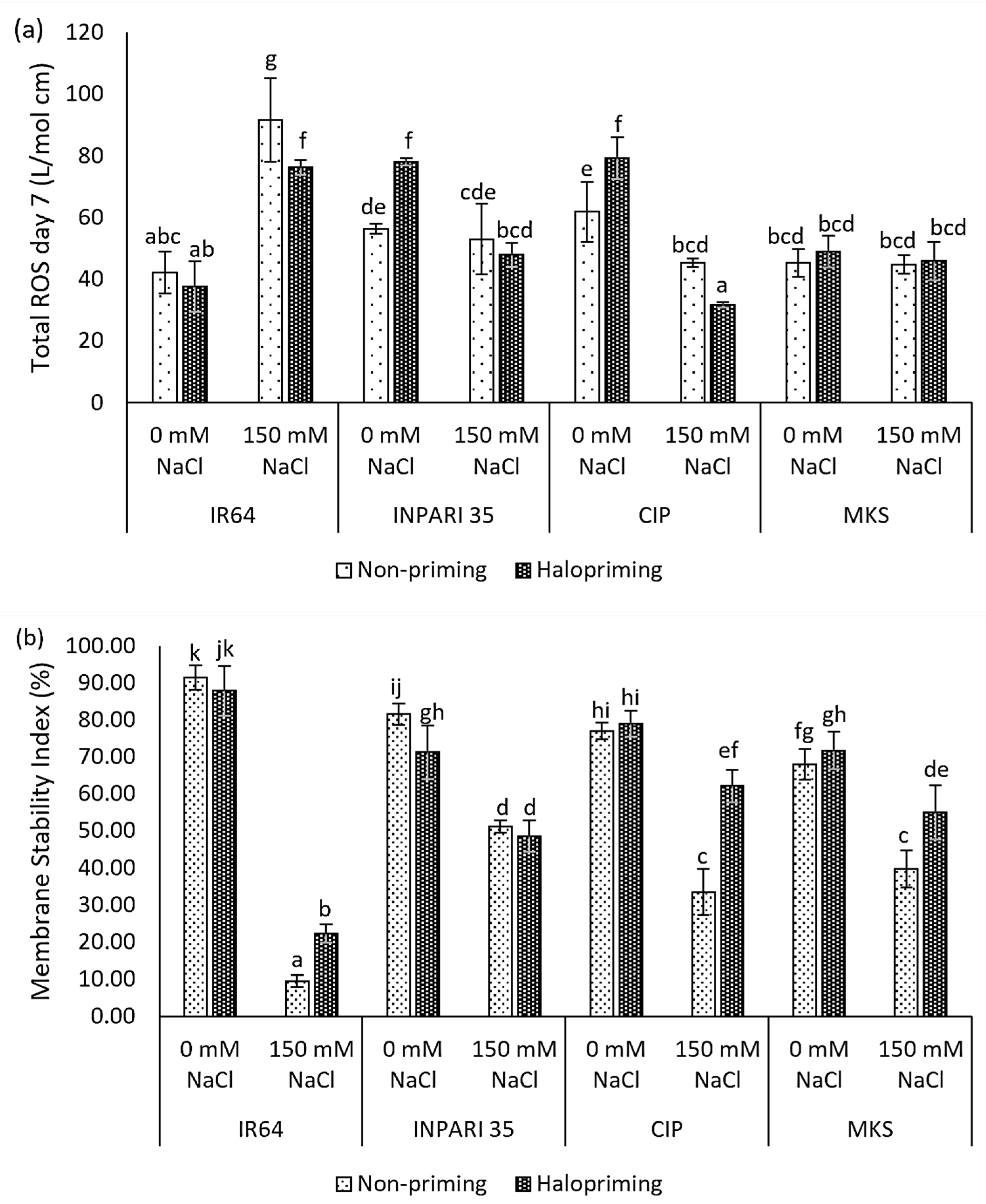
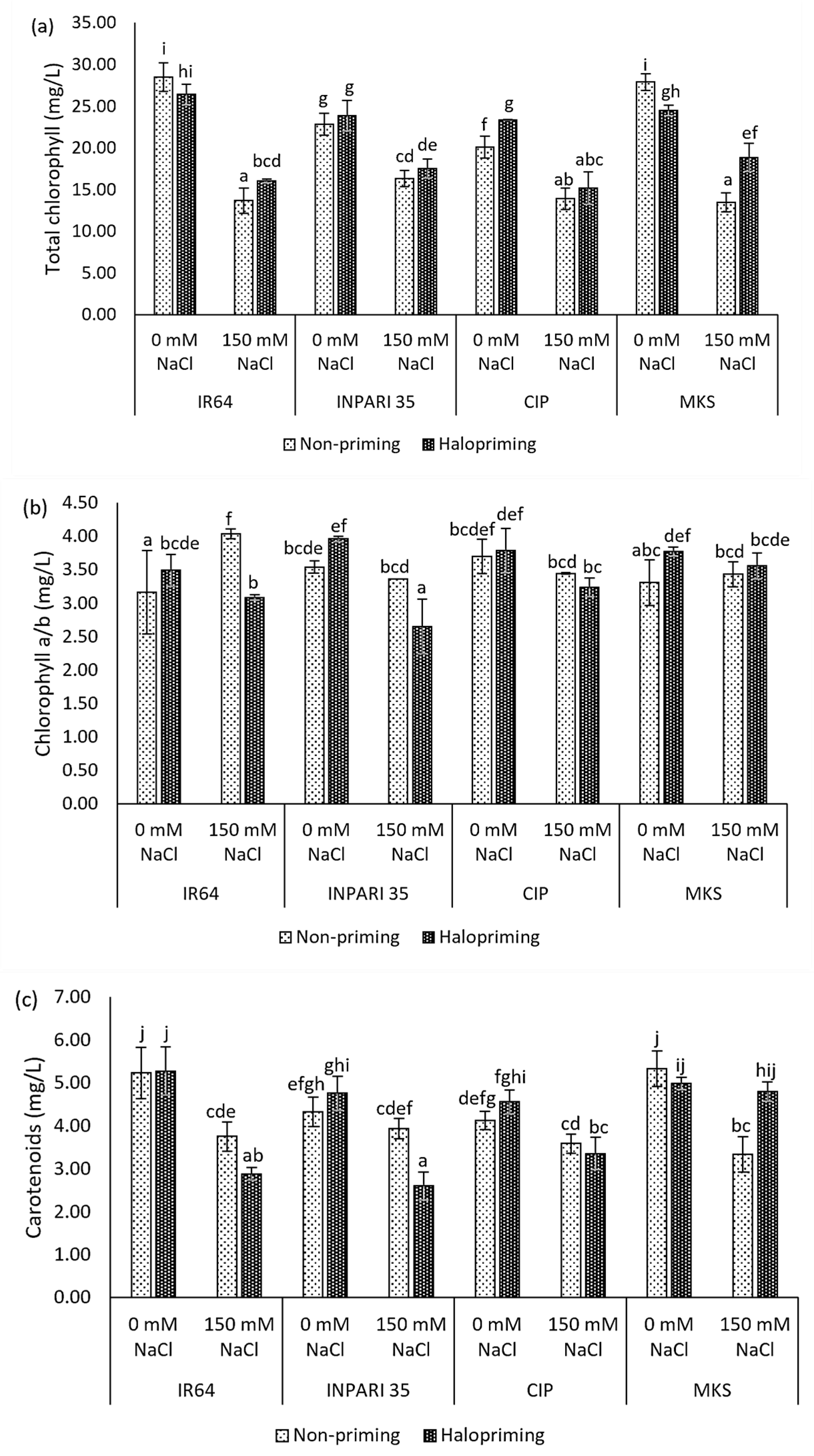
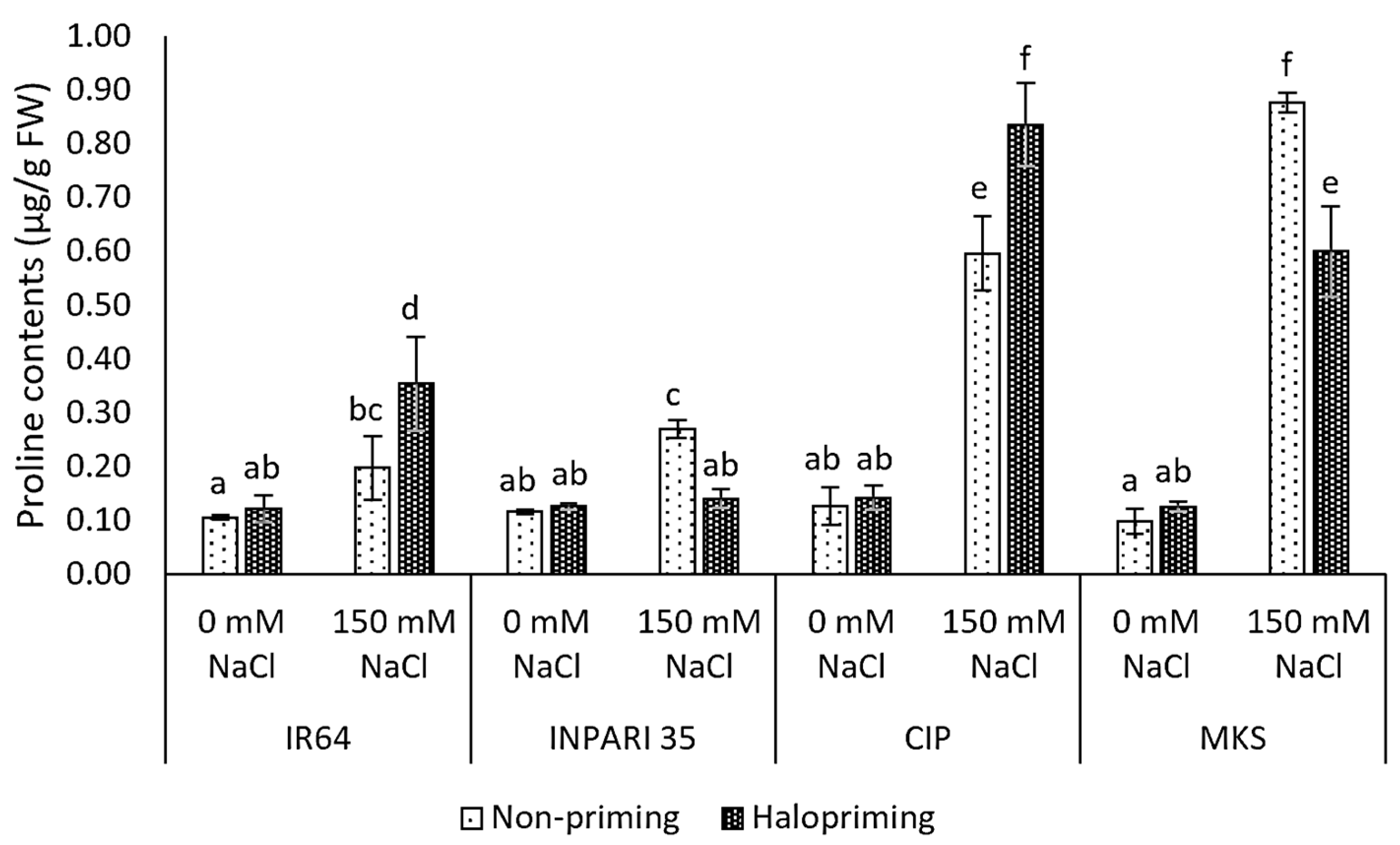

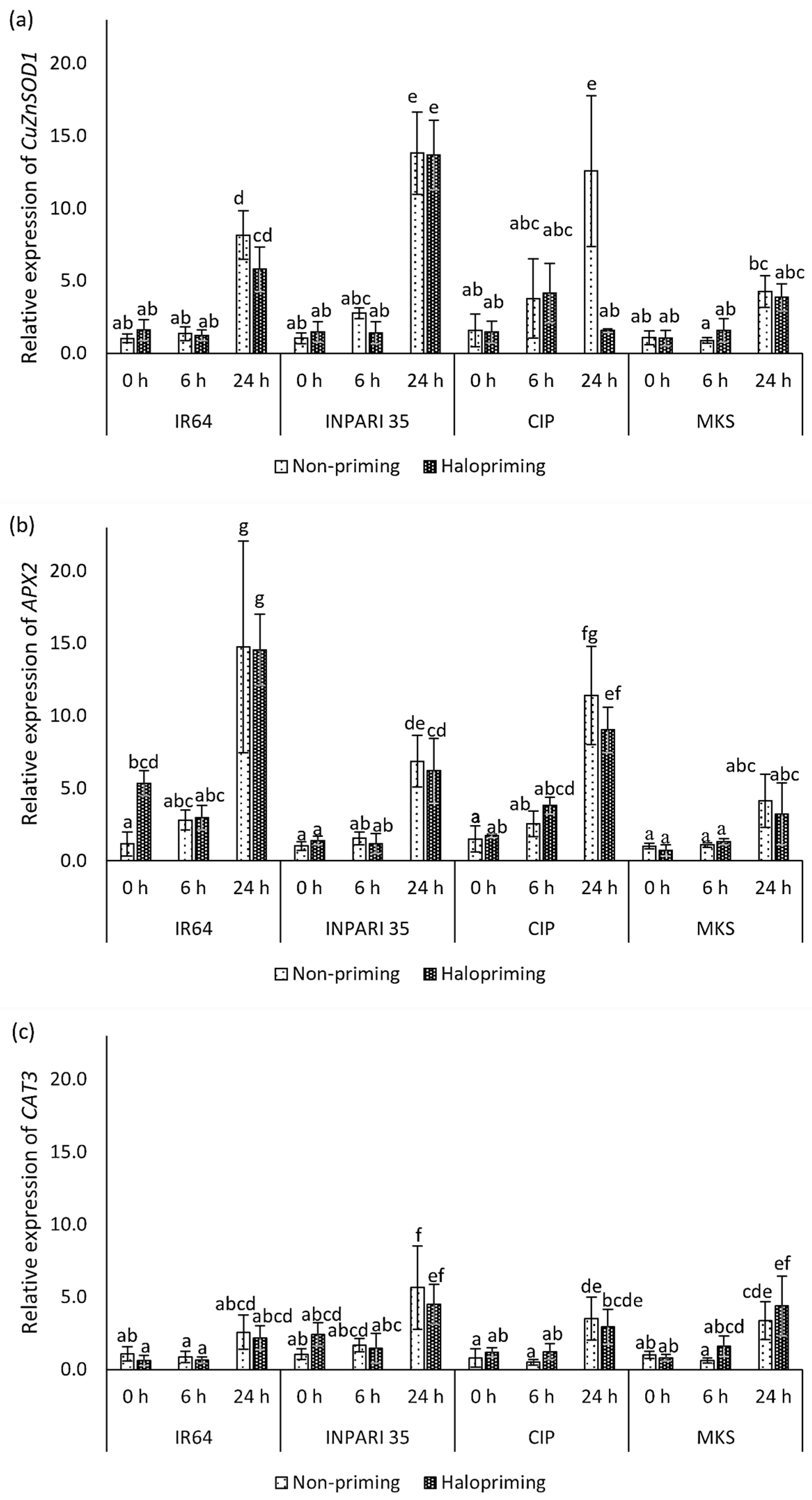

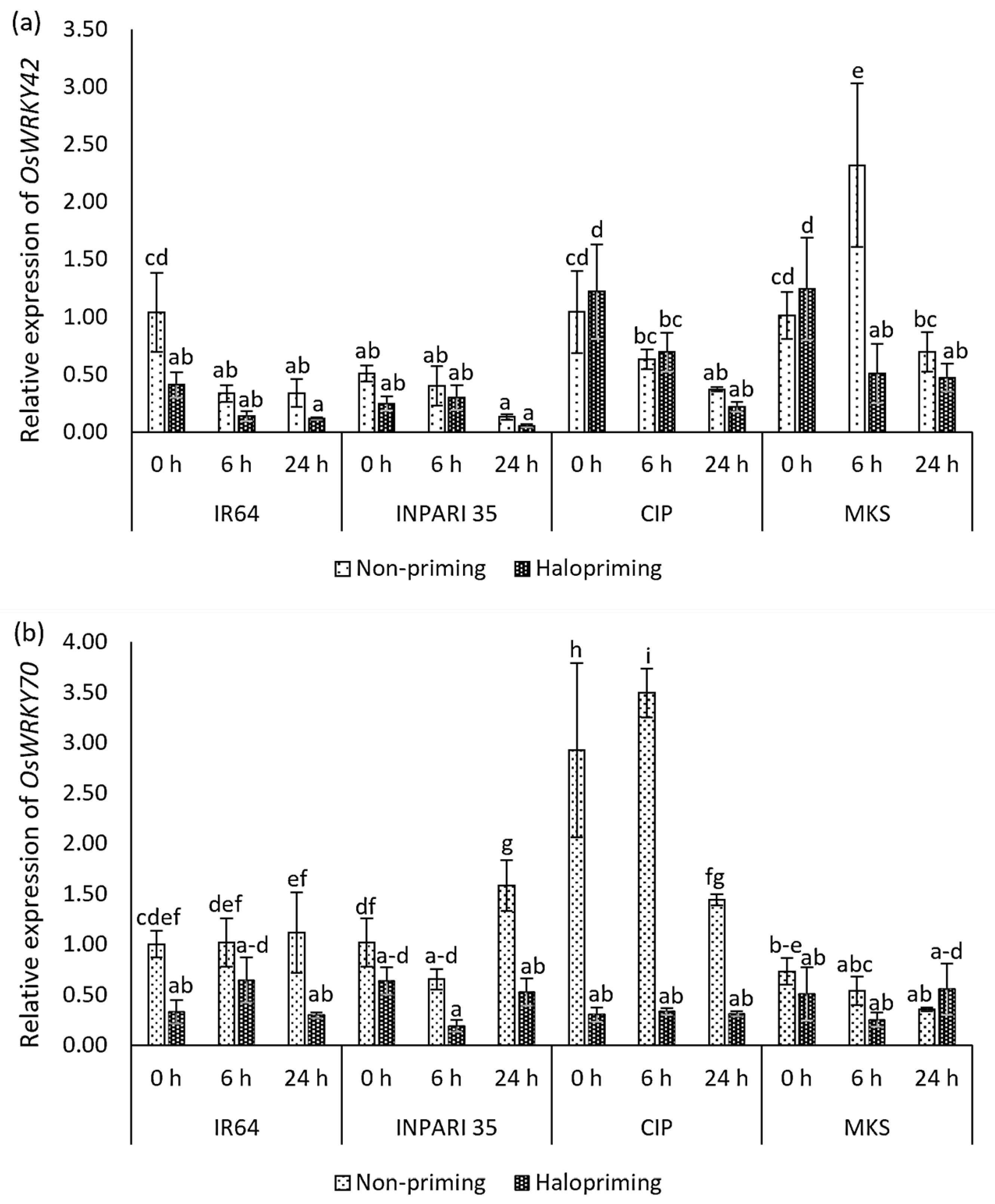
| Cultivar | Pre- Treatment | Germination Rate (%)/Day | MGT (Days) | ||||||
|---|---|---|---|---|---|---|---|---|---|
| 1 | 2 | 3 | 4 | 5 | 6 | 7 | |||
| IR64 | NP | 85 ± 10 | 94 ± 5 | 97 ± 3 | 100 ± 0 | 100 ± 0 | 100 ± 0 | 100 ± 0 | 1.24 ± 0.16 a |
| HP | 63 ± 8 | 94 ± 7 | 96 ± 4 | 100 ± 0 | 100 ± 0 | 100 ± 0 | 100 ± 0 | 1.47 ± 0.17 b | |
| INPARI 35 | NP | 89 ± 4 | 96 ± 4 | 97 ± 4 | 100 ± 0 | 100 ± 0 | 100 ± 0 | 100 ± 0 | 1.18 ± 0.11 a |
| HP | 91 ± 5 | 94 ± 2 | 97 ± 3 | 100 ± 0 | 100 ± 0 | 100 ± 0 | 100 ± 0 | 1.18 ± 0.06 a | |
| CIP | NP | 12 ± 6 | 88 ± 3 | 96 ± 2 | 100 ± 0 | 100 ± 0 | 100 ± 0 | 100 ± 0 | 2.00 ± 0.05 c |
| HP | 0 ± 0 | 87 ± 7 | 92 ± 3 | 100 ± 0 | 100 ± 0 | 100 ± 0 | 100 ± 0 | 2.21 ± 0.09 d | |
| MKS | NP | 62 ± 6 | 98 ± 3 | 100 ± 0 | 100 ± 0 | 100 ± 0 | 100 ± 0 | 100 ± 0 | 1.40 ± 0.08 b |
| HP | 39 ± 7 | 100 ± 0 | 100 ± 0 | 100 ± 0 | 100 ± 0 | 100 ± 0 | 100 ± 0 | 1.61 ± 0.07 c | |
| Cultivar | Pre- Treatment | Plant Height (cm) | Root Length (cm) | RWC (%) | |||
|---|---|---|---|---|---|---|---|
| 0 mM | 150 mM | 0 mM | 150 mM | 0 mM | 150 mM | ||
| IR64 | NP | 34.2 ± 1.0 ab | 31.5 ± 0.9 a | 11.3 ± 0.6 cd | 8.5 ± 0.5 ab | 90.0 ± 3.51 cde | 81.8 ± 0.79 b |
| HP | 35.8 ± 0.9 bc | 31.6 ± 1.0 a | 10.2 ± 0.4 bc | 7.8 ± 1.1 a | 94.8 ± 2.80 f | 89.9 ± 2.81 c | |
| INPARI 35 | NP | 47.5 ± 1.2 fg | 40.2 ± 1.5 d | 14.7 ± 1.2 ef | 9.3 ± 0.6 abc | 95.4 ± 1.09 f | 88.9 ± 3.32 cde |
| HP | 50.0 ± 1.5 g | 40.8 ± 1.6 de | 15.9 ± 2.9 f | 9.7 ± 1.3 abc | 93.8 ± 1.98 ef | 86.5 ± 2.93 c | |
| CIP | NP | 46.8 ± 0.8 e | 41.0 ± 1.7 de | 13.3 ± 1.2 e | 9.1 ± 0.8 ab | 94.5 ± 2.28 f | 82.4 ± 0.99 ab |
| HP | 43.1 ± 3.5 de | 40.5 ± 2.2 de | 12.8 ± 1.5 de | 10.5 ± 0.2 bc | 95.2 ± 2.54 f | 80.4 ± 2.15 b | |
| MKS | NP | 39.9 ± 0.5 d | 36.4 ± 2.3 bc | 8.6 ± 0.8 ab | 8.9 ± 0.8 ab | 93.3 ± 1.79 ef | 80.05 ± 4.29 ab |
| HP | 36.8 ± 0.4 bc | 38.5 ± 0.9 cd | 11.3 ± 0.8 cd | 8.9 ± 0.4 ab | 92.8 ± 0.47 def | 76.65 ± 0.82 a | |
| Gene | Sequence (5′ → 3′) | Amplicon Size (bp) |
|---|---|---|
| CuZnSOD1 | F: GAGATTCCAAACCAGCAGGA | 277 |
| R: TTGTAGTGTGGCCCAGTTGA | ||
| APX2 | F: TCTTCCTGATGCCACACAAG | 298 |
| R: GTCCTCATCCGCAGCATATT | ||
| CAT3 | F: ACCGGTTCATCAAGAGATGG | 304 |
| R: ACACGAATTGTGCGGTGATA | ||
| OsMYB91 | F: CCACCTCCTTTACTTGAGC | 161 |
| R: ATCCTGCTGCTCTGTTCTT | ||
| OsWRKY42 | F: ACGACTGACCAAACTACTGG | 158 |
| R: CAATTGGCAAATACTACGTG | ||
| OsWRKY70 | F: CGTATAGGGAGAACGAGAAA | 183 |
| R: ATAGCAAAGCCATAGAACGA | ||
| OsP5CS1 | F: TTCTTGGGCATGCTGATGGT | 192 |
| R: ATTGCAGGCTGCTGGGTAAT | ||
| UBQ | F: AACCAGCTGAGGCTGATGGT | 77 |
| R: ATTGCAGGCTGCTGGGTAAT |
Disclaimer/Publisher’s Note: The statements, opinions and data contained in all publications are solely those of the individual author(s) and contributor(s) and not of MDPI and/or the editor(s). MDPI and/or the editor(s) disclaim responsibility for any injury to people or property resulting from any ideas, methods, instructions or products referred to in the content. |
© 2023 by the authors. Licensee MDPI, Basel, Switzerland. This article is an open access article distributed under the terms and conditions of the Creative Commons Attribution (CC BY) license (https://creativecommons.org/licenses/by/4.0/).
Share and Cite
Purwestri, Y.A.; Nurbaiti, S.; Putri, S.P.M.; Wahyuni, I.M.; Yulyani, S.R.; Sebastian, A.; Nuringtyas, T.R.; Yamaguchi, N. Seed Halopriming: A Promising Strategy to Induce Salt Tolerance in Indonesian Pigmented Rice. Plants 2023, 12, 2879. https://doi.org/10.3390/plants12152879
Purwestri YA, Nurbaiti S, Putri SPM, Wahyuni IM, Yulyani SR, Sebastian A, Nuringtyas TR, Yamaguchi N. Seed Halopriming: A Promising Strategy to Induce Salt Tolerance in Indonesian Pigmented Rice. Plants. 2023; 12(15):2879. https://doi.org/10.3390/plants12152879
Chicago/Turabian StylePurwestri, Yekti Asih, Siti Nurbaiti, Sekar Pelangi Manik Putri, Ignasia Margi Wahyuni, Siti Roswiyah Yulyani, Alfino Sebastian, Tri Rini Nuringtyas, and Nobutoshi Yamaguchi. 2023. "Seed Halopriming: A Promising Strategy to Induce Salt Tolerance in Indonesian Pigmented Rice" Plants 12, no. 15: 2879. https://doi.org/10.3390/plants12152879
APA StylePurwestri, Y. A., Nurbaiti, S., Putri, S. P. M., Wahyuni, I. M., Yulyani, S. R., Sebastian, A., Nuringtyas, T. R., & Yamaguchi, N. (2023). Seed Halopriming: A Promising Strategy to Induce Salt Tolerance in Indonesian Pigmented Rice. Plants, 12(15), 2879. https://doi.org/10.3390/plants12152879








